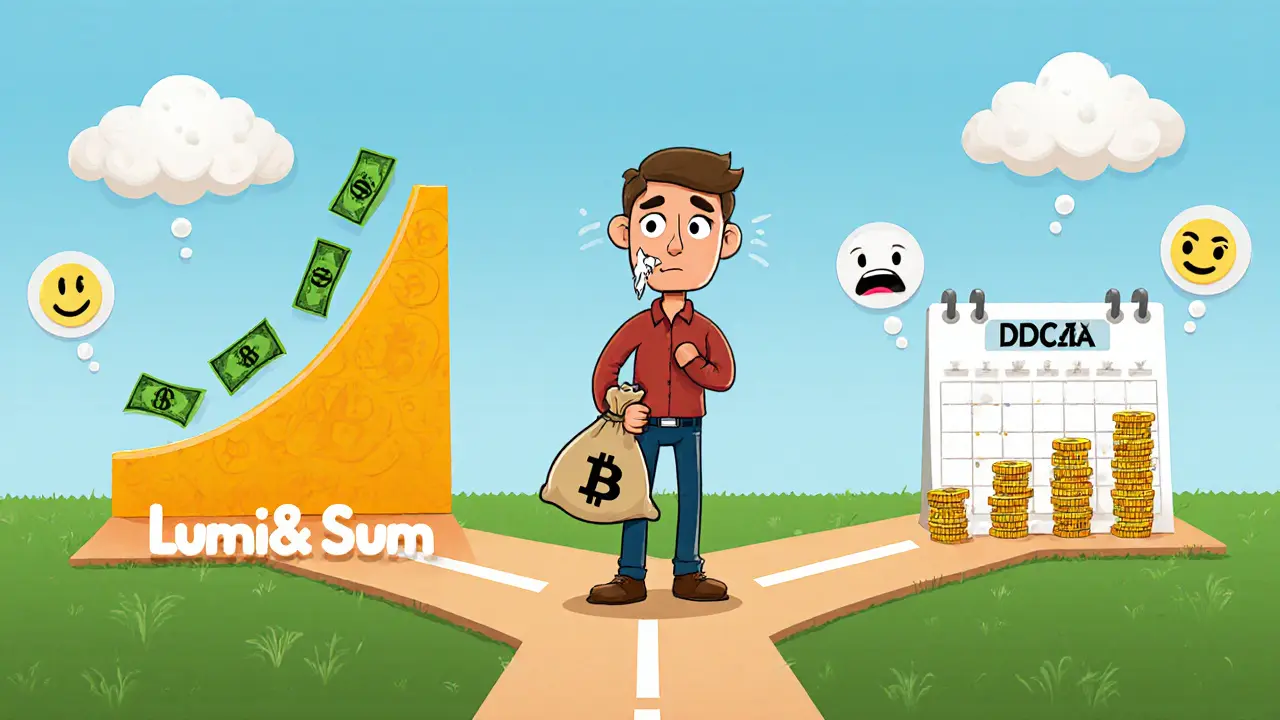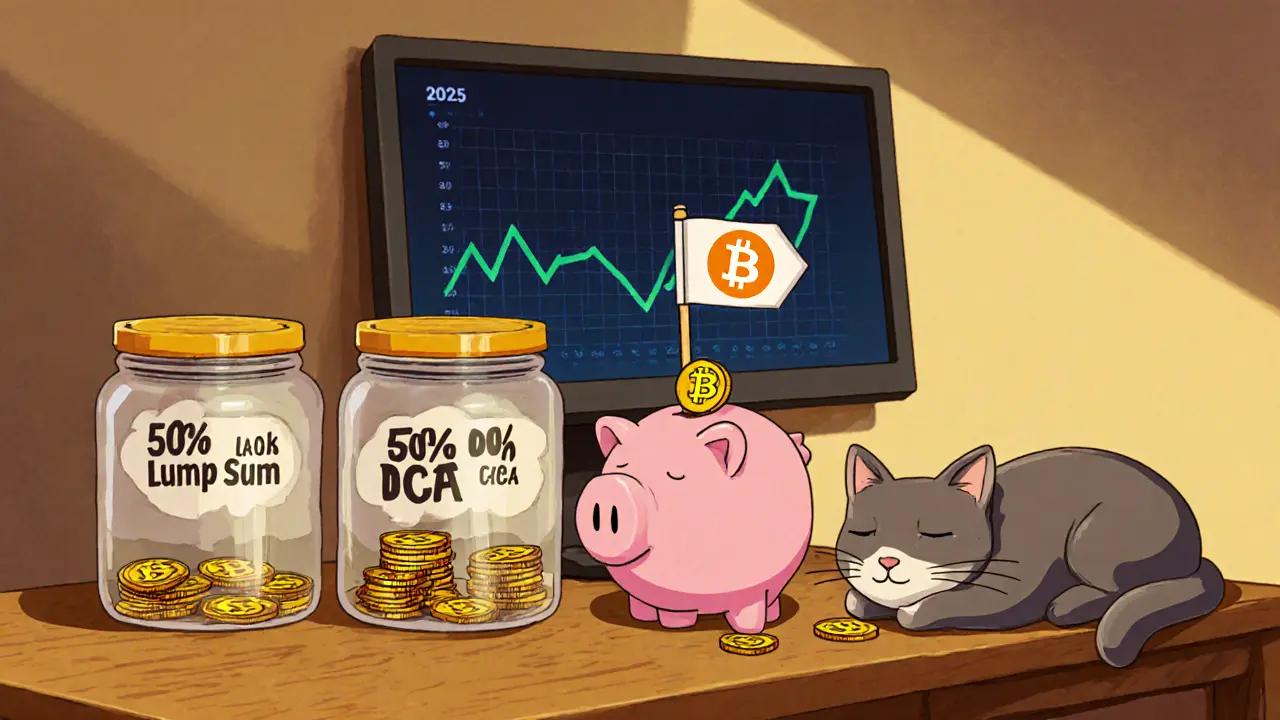DCA vs Lump Sum Investment in Crypto: Which Strategy Wins in 2025?
 Sep, 7 2025
Sep, 7 2025
Crypto Investment Strategy Calculator
Investment Calculator
Strategy Comparison
Fees: $
Fees: $
Which Strategy Wins?
What’s the real difference between DCA and lump sum in crypto?
You’ve got $5,000 to invest in Bitcoin or Ethereum. Do you dump it all in today, or spread it out over months? This isn’t just a math problem-it’s a mental one. Most people think the better strategy is the one that makes the most money. But in crypto, the strategy that keeps you holding through the panic? That’s often the real winner.
Let’s cut through the noise. Backtesting shows lump sum investing beats DCA about 68% of the time over the long run. That’s not a fluke. If you’d invested $10,000 in Bitcoin all at once in 2020, you’d have made more than if you’d spread it out over 12 months. The math doesn’t lie. But here’s the catch: most people can’t handle that kind of pressure.
Why lump sum works better on paper
Crypto markets trend upward over time. Bitcoin doesn’t sit still. It climbs, corrects, climbs again. Lump sum investing means you’re fully exposed to that upward drift from day one. Every dollar you wait to invest is a dollar missing out on growth.
Take the 2021-2024 bull run. Someone who invested $24,000 in Bitcoin all at once in April 2021 ended up with $49,363. That’s a 106% gain. Meanwhile, someone using DCA over the same period? They ended up with less-because they were buying at higher prices as the market rose. Nakamoto Portfolio’s data shows DCA investors accumulated nearly 75% less Bitcoin over 12 months compared to lump sum.
And fees? Lump sum wins there too. Buying $10,000 in one go on Coinbase costs $60 in fees (0.6%). Split that into ten $1,000 buys? That’s $600 in fees. That’s a 10x difference. In crypto, where every dollar counts, that adds up fast.
Why so many people still choose DCA
Here’s the truth: most crypto investors aren’t professionals. They’re teachers, nurses, software devs, parents. They don’t have a trading desk. They don’t watch charts all day. They just want to get in without losing sleep.
DCA lets you do that. Buy $50 every Friday. No stress. No timing pressure. You don’t need to predict the bottom. You don’t need to panic when Bitcoin drops 20% in a week. You just keep buying. And that consistency? It builds discipline.
Reddit’s r/CryptoCurrency has over 1,200 comments from early 2024 analyzing this exact question. 78% of users recommended DCA for beginners. One user, u/CryptoNewbie2023, wrote: “I DCA $100 weekly into BTC and ETH. Last year I bought at $25k and $65k. Doesn’t matter-my average is $42k.” That’s the power of averaging. You’re not betting on one price. You’re betting on time.

The hidden cost of lump sum: your emotions
Let’s say you put $5,000 into Bitcoin at $16,000 in early 2023. Two weeks later, it’s at $19,000. You’re golden. Then it drops to $12,000. Now you’re sweating. Your stomach is in knots. You check your wallet every 10 minutes. You start reading doom posts on Twitter. You almost sell.
That’s the emotional toll of lump sum. And it’s real. 43% of lump sum investors in BitcoinIRA’s 2024 survey sold during a 30%+ drop. That’s not a market failure-that’s a human failure. The market didn’t crash. You did.
DCA removes that pressure. You’re not all in. You’re not watching every tick. You’re building a position slowly. When the price drops, you buy more. When it rises, you keep going. You’re not trying to win a race. You’re trying to finish the marathon.
When DCA shines: bear markets and uncertainty
DCA isn’t just for beginners. It’s a survival tool in bad markets.
Look at April 2021 to March 2025. Bitcoin went from $59,000 to $71,000-but it crashed hard in between. In 2022, it dropped below $17,000. If you’d invested $24,000 all at once in April 2021, you’d have lost over half your money by late 2022. But if you’d DCA’d that same $24,000 over 36 months? You ended up with $60,881. That’s a 154% gain.
Why? Because DCA lets you buy more when prices are low. When Bitcoin was at $17,000, your $100 buys 0.0058 BTC. When it’s at $70,000, your $100 buys 0.0014 BTC. Over time, you accumulate more coins at cheaper prices. That’s the magic of averaging down.
Yellow.com’s 2024 analysis confirmed this: “DCA excels during extended bear markets and periods of high uncertainty.” That’s not theory. That’s history.
What about hybrid strategies?
What if you don’t have to pick one? More investors are blending both.
38% of new investors in Q2 2024 used a hybrid approach: put 50% in as a lump sum, and DCA the other 50% over 6-12 months. This gives you exposure to upside while protecting you from a crash. It’s a middle path that balances math and psychology.
Platforms like Binance and Coinbase now make this easy. You can set up recurring buys alongside one-time purchases. Some even let you automate DCA down to $1 increments using blockchain-based tools like DCA Bot.
And here’s something interesting: institutional investors are mostly lump sum (92% in Q1 2024). Retail investors? 72% use DCA. Why? Institutions have teams, risk models, and cold storage. Retail investors have nerves and bank accounts. Different tools for different people.

Which strategy should you pick?
It’s not about which one is “better.” It’s about which one fits you.
Choose lump sum if:
- You’re confident in the long-term trend of crypto
- You can handle 30-50% drawdowns without selling
- You have the time to research entry points
- You’re comfortable paying lower fees
Choose DCA if:
- You’re new to crypto
- You don’t want to time the market
- You get anxious watching prices swing
- You want to build the habit of consistent investing
There’s no shame in DCA. In fact, the University of Zurich’s 2023 research found that DCA’s psychological benefits lead to better long-term outcomes for retail investors-even if it means lower returns on paper.
How to start today
Here’s how to make it real:
- Decide how much you can invest monthly without stress. Start small-$10, $25, $50.
- Use a platform with auto-buy: Coinbase, Binance, or Kraken all offer recurring purchases.
- Set it on a day you get paid. Friday after payday? Perfect.
- Turn off price alerts. Don’t check your wallet daily.
- Stick with it for at least 12 months. That’s the minimum to see the pattern.
If you go lump sum? Don’t chase the bottom. Pick a price you’re comfortable with. Buy once. Then walk away. Don’t look at it for 30 days. Let time do the work.
What’s next? Markets are changing
The crypto market isn’t what it was in 2021. Halvings are less dramatic. Regulation is clearer. Institutions are in. Volatility is still high-but it’s less extreme than before.
Experts like Rapha Zagury of Nakamoto Portfolio predict the performance gap between DCA and lump sum will shrink to 5-10% over the next few years. That means the emotional benefits of DCA might soon outweigh the small math disadvantage.
Either way, both strategies are here to stay. The best investor isn’t the one who picks the perfect entry. It’s the one who stays in the game.
Grace Zelda
November 27, 2025 AT 07:16Also, fees? Yeah, they add up, but if you’re buying $50 at a time on Kraken, you’re still paying less than $1 per transaction. It’s not the end of the world. It’s the start of a habit.
Kristi Malicsi
November 27, 2025 AT 19:15